
SKIING HISTORY
Editor Kathleen James
Art Director Edna Baker
Contributing Editor Greg Ditrinco
ISHA Website Editor Seth Masia
Editorial Board
Seth Masia, John Allen, Andy Bigford, John Caldwell, Jeremy Davis, Kirby Gilbert, Paul Hooge, Jeff Leich, Bob Soden, Ingrid Wicken
Founding Editors
Morten Lund, Glenn Parkinson
To preserve skiing history and to increase awareness of the sport’s heritage
ISHA Founder
Mason Beekley, 1927–2001
ISHA Board of Directors
Seth Masia, President
Wini Jones, Vice President
Jeff Blumenfeld, Vice President
John McMurtry, Vice President
Chan Morgan, Treasurer
Einar Sunde, Secretary
Richard Allen, Skip Beitzel, Michael Calderone, Christin Cooper, Art Currier, Dick Cutler, Chris Diamond, Mike Hundert, David Ingemie, Rick Moulton, Wilbur Rice, Charles Sanders, Bob Soden (Canada)
Presidential Circle
Christin Cooper, Billy Kidd, Jean-Claude Killy, Bode Miller, Doug Pfeiffer, Penny Pitou, Nancy Greene Raine
Business & Events Manager
Kathe Dillmann
P.O. Box 1064
Manchester Center VT 05255
(802) 362-1667
kathe@skiinghistory.org
Membership Services
Laurie Glover
(802) 375-1105
laurie@skiinghistory.org
Corporate Sponsorships
Peter Kirkpatrick
(541) 944-3095
peterk10950@gmail.com
Bimonthly journal and official publication of the International Skiing History Association (ISHA)
Partners: U.S. Ski and Snowboard Hall of Fame | Canadian Ski Museum and Hall of Fame
Alf Engen Ski Museum | North American Snowsports Journalists Association | Swiss Academic Ski Club
Skiing History (USPS No. 16-201, ISSN: 23293659) is published bimonthly by the International Skiing History Association, P.O. Box 1064, Manchester Center, VT 05255.
Periodicals postage paid at Manchester Center, VT and at additional mailing offices. Postmaster: Send address changes to ISHA, P.O. Box 1064, Manchester Center, VT 05255
ISHA is a 501(c)(3) public charity. EIN: 06-1347398
Written permission from the editor is required to reproduce, in any manner, the contents of Skiing History, either in full or in part.
The Sour Cream Sierras
Thousands learned to ski at the Borscht Belt hotels of New York's Catskill Mountains.
Starting in the early 1950s, hundreds of thousands of Americans learned to ski not on the slopes of major resorts like Sun Valley, Stowe or Aspen, but at more prosaic ski areas and resort hotels with names like Big Vanilla at Davos, the Concord, Gibber’s, the Granit, Grossingers, Homowack Lodge, Kutsher’s, Laurels, the Nevele, the Pines and the Raleigh. These were among the Borscht Belt hotels in the Catskills, about 90 miles northwest of New York City.
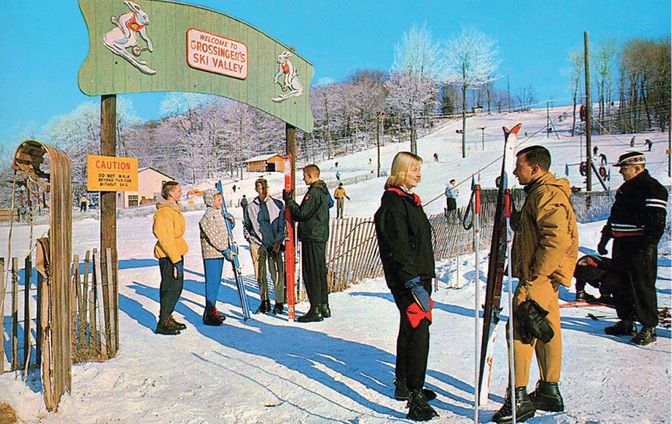
The Borscht Belt—named for a sweet-and-sour beet soup associated with immigrants from eastern Europe—identifies the show-biz culture that arose from Yiddish theater and spawned comedians such as Lenny Bruce, Red Buttons, Sid Caesar, Billy Crystal, Buddy Hackett, Danny Kaye, Carl Reiner and Jerry Stiller. They honed their stand-up acts in the region also affectionately nicknamed the Sour Cream Sierras (sweet red borscht was often served with a dollop of sour cream), or even the Jewish Alps.
The resorts became fictional locations for movies like Dirty Dancing and A Walk on the Moon, and TV shows like The Marvelous Mrs. Maisel, although some were actually shot at look-alike resorts in Virginia, North Carolina or the Adirondacks.
“From the early ’50s up to the early ’70s, the area’s hotels were a haven for upwardly mobile Jewish families who came year-round to eat prodigious amounts of food and chortle at comedians like Jerry Lewis who defined their era,” says Steve Cohen, who wrote lively articles about the Catskills for SKI in 2000 and 2006.
Legendary New York Times snowsports journalist Michael Strauss wrote in SKI in January 1960 (subsequently reprinted in “Borscht, Bagels and Bindings,” Skiing Heritage, December 2000) that “The Catskills were the Alps of mid-coast, middle-class Americans on ski vacations in the mid-20th century.”
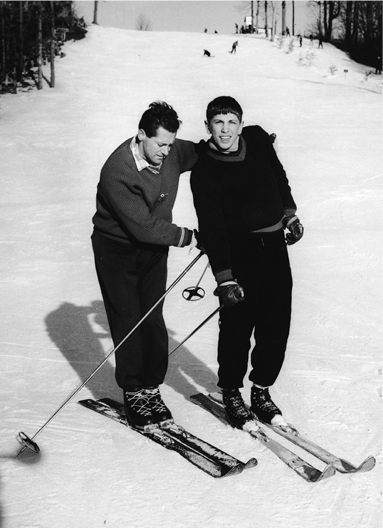
He credits Swiss-born instructor Tino Koch for taking “dime-sized beginner’s areas and turning out hundreds of polished beginners yearning for the more trying slopes of upper New York State and New England.”
For me, it was my boyhood home. Living just a few miles from tiny Holiday Mountain was a dream come true for me, although not so much for drivers who had to contend with machine-made snow drifting onto the adjacent Route 17. Holiday offered only a 400-foot vertical, but I remember the glee of endlessly yo-yoing its narrow white-gauze-bandage runs, riding a Poma and two slow double chairs on weekends and Wednesday evenings after school. I was part of a local vacation attraction that dated back almost 100 years.
SKIING BEFORE THE WAR
Beginning in 1936, Liberty Winter Sports operated the Walnut Mountain rope tow in Liberty, on the site of the now-demolished Walnut Mountain House. Skiers brought refreshments in knapsacks and sunned, like lizards, atop a boulder, according to the CD-ROM Liberty, NY: Memories, produced by Between The Lakes Group (Taconic, Connecticut). In the era before snowmaking, Walnut Mountain depended on natural snowfall. With World War II, and the departure of its male skiers to war, Walnut closed.
October 1948 saw the launch of Christmas Hills in Livingston Manor, now a partially gentrified second home community in the northern part of Sullivan County. According to Sullivan County historian John Conway, writing for the New York Almanack, Christmas Hills had a lot going for it, and there were high hopes for its success. Conway quotes Jeffersonville’s Sullivan County Record (October 21, 1948): “During its first season of operation Christmas Hills will be open every weekend, except during the holiday season when a daily schedule will take effect. It will provide two of the latest type electric ski tows, varied slopes, including alternate ski trails through the woods and a professional ski school.”
The Republican Watchman reported the next day, “There will be the added feature of ‘ski-joring’—the use of a horse for level towing on skis—is planned (sic) as an added thrill for the fast growing ski public.
“The Christmas Hills slopes compare favorably with the best on the Eastern Seaboard. More than 1,500 feet long, the main ski run varies in rise from 30 degrees for the ski expert to a mild 10 to 15 degrees for beginners. Snow conditions should be ideal over a long period and the southern exposure of the slopes afford an exceptionally beautiful setting.”
Conway writes, “Just as it had with the Walnut Mountain ski hill a decade before, the lack of snow prevented Christmas Hills from ever becoming as successful as it might have been.”

The Concord Hotel in nearby Kiamesha Lake has claimed to be the first ski area to make its own snow (that honor belongs to Mohawk Mountain, which installed Wayne Pierce’s new snow gun in 1950). But the Concord was certainly the first ski area to blow pink and blue snow. Michael Strauss of the New York Times reported that the dye used to color Concord snow badly stained the pants and sweaters of beginners who fell in it.
By 1958, Conway wrote, the hotel was operating an Austrian-manufactured T-bar capable of transporting 460 skiers per hour. Vertical drop was 139 feet.
“At Grossinger’s, before snowmaking equipment was installed in 1952, it was a common practice to physically move as much snow as possible from the hotel’s extensive property to the ski area in order to accommodate the skiers,” Conway wrote. “It was not a foolproof plan, and only occasionally provided satisfactory results.” They also experimented with a surface of ground-up plastic collar buttons.
In the late 1950s, Holiday Mountain Ski Area in Bridgeville was fully operational and billed itself as the closest ski area of its kind to New York City.
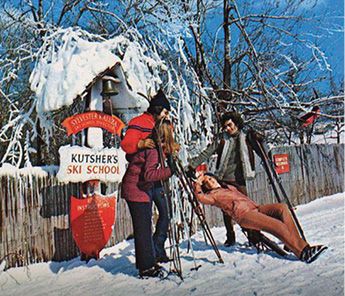
“It will be no layout to captivate the imagination of experts accustomed to tearing down Stowe’s Nosedive or Mount Greylock’s Thunderbolt, but it will more than suffice for the run-of-the-mill sports lover who wants to test his legs as well as enjoy the sport with a minimum risk of injury,” predicted Michael Strauss in the New York Times on December 8, 1957.
According to Conway’s book, Remembering the Sullivan County Catskills (History Press, 2008), “Holiday Mountain continued to improve its operation over the next several years, and managed to survive the opening of the larger and better equipped Davos in Woodbridge in 1959, as well as the advent and expansion of other ski hills, including the nearby Columbia and the Pines, which, in 1965, became the first hotel to feature a chairlift.”
By 1960, Holiday Mountain was facing stiff competition. There were numerous Sullivan County hotels offering skiing, along with ice skating, tobogganing, endless games of Simon Sez, and the attraction of all-you-can-eat meals. Yet today, Holiday is the county’s only stand-alone ski area, helped in part by reinventing itself as a Ski and Fun Park.
Frozen in Time
Barry Levinson, 59, is a 40-year veteran of the ski industry who teaches part-time at Vail. He was born in Monticello, the county seat of Sullivan County, where he lived for 18 years—in fact, next door to me. We sledded and skied on the hill between our homes. Last summer he returned to the southern Catskills to document the lost ski areas of his youth.
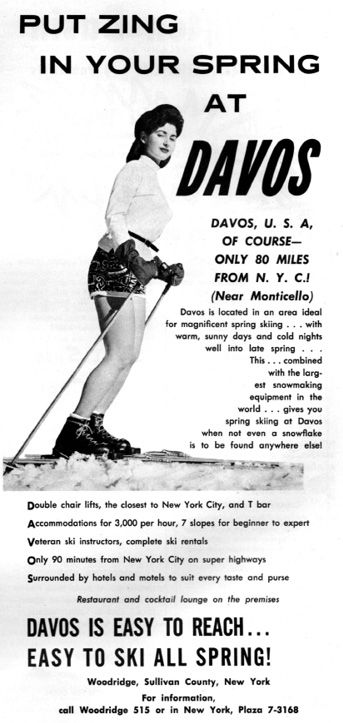
Davos, offered three chairlifts, four T-bars and a rope tow on a vertical drop of 450 feet. It was popular with beginners and intermediates from nearby New York City.
His Catskill Skiing History page on Facebook documents the remains of dozens of Borscht Belt ski areas. One photo shows a solitary cableless bullwheel at the remains of Big Vanilla at Davos, where at its prime, a waiter in the base lodge would warm your hot toddys with a glowing poker. There are images of chairlifts rotting into the ground and a vintage snowcat stored in a shed with mechanic tools nearby. A YouTube video of Nevele Resort shows skis strewn in the base lodge. A sign offers $20 group
and $60 private lessons (see https://tinyurl.com/neveleruins).
In a recent call with Skiing History, Levinson likened abandoned Catskill ski hills to Chernobyl. “It’s totally frozen in time,” he said. “A post apocalyptic scene. It’s depressing as hell, but fascinating…I documented these lost ski areas out of a sense of nostalgia. Growing up in the Catskills when I was a kid was a nice place to be,” he says.
“While I thought Holiday Mountain was too small, I realized in the grand scheme of things we were lucky to have it. What else would we have done up there in the winter?”
Southern Catskill hotel skiing failed to prosper into the 21st century, with the exception of a small still-operating hill at the Italian-American Villa Roma Resort in Callicoon. Nonetheless, as Michael Strauss wrote in SKI, “there are tens of thousands of Americans skiing today on bigger, better mountains, thanks partly to the early chutzpah of Catskill hoteliers.” 
ISHA vice president Jeff Blumenfeld is president of the North American Snow-sports Journalists Association (NASJA.org) and author of Travel With Purpose: A Field Guide to Voluntourism (Rowman & Littlefield, 2019). Learn more at travelwithpurposebook.com.

Table of Contents
2020 Corporate Sponsors
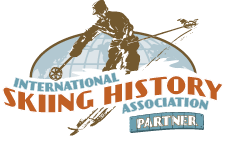
World Championship
($3,000 and up)
Alyeska Resort
Gorsuch
Intuition Sports, Inc.
Obermeyer
Polartec
Warren and Laurie Miller
Snowsports Merchandising Corporation
World Cup ($1,000)
Active Interest Media | SKI & Skiing
Aspen Skiing Company
BEWI Productions
Bogner
Boyne Resorts
Country Ski & Sport
Dale of Norway
Darn Tough Vermont
Descente North America
Dynastar | Lange | Look
Fairbank Group: Bromley, Cranmore, Jiminy Peak
Fera International
Gordini USA Inc. | Kombi LTD
HEAD Wintersports
Hickory & Tweed Ski Shop
Mammoth Mountain
Marker-Völkl USA
National Ski Areas Association (NSAA)
Outdoor Retailer
POWDR Adventure Lifestyle Corp.
Rossignol
Ski Area Management
Sun Valley Resort
Vintage Ski World
World Cup Supply, Inc.
Gold ($700)
Race Place | BEAST Tuning Tools
The Ski Company (Rochester, NY)
Thule
Silver ($500)
Alta Ski Area
Clic Goggles
Dalbello Sports
Deer Valley
Ecosign Mountain Resort Planners
Hertel Ski Wax
Holiday Valley
Hotronic USA, Inc. | Wintersteiger
MasterFit Enterprises
Metropolitan New York Ski Council
Mt. Bachelor
NILS, Inc.
Portland Woolen Mills
Russell Mace Vacation Homes
Schoeller Textile USA
Scott Sports
Seirus Innovations
SeniorsSkiing.com
Ski Utah
Snow Time, Inc.
Sports Specialists, LTD
SympaTex
Tecnica Group USA
Timberline Lodge & Ski Area
Trapp Family Lodge
Vuarnet
Western Winter Sports Reps Association
World Pro Ski Tour
For information, contact: Peter Kirkpatrick | 541.944.3095 | peterk10950@gmail.com
ISHA deeply appreciates your generous support!


